You have no items in your shopping cart.
| Catalog Number | orb345398 |
|---|---|
| Category | Antibodies |
| Description | HA EPITOPE TAG antibody |
| Clonality | Polyclonal |
| Species/Host | Rabbit |
| Isotype | IgG |
| Conjugation | Unconjugated |
| Form/Appearance | Liquid (sterile filtered) |
| Concentration | 1.05 mg/mL |
| Buffer/Preservatives | 0.01% (w/v) Sodium Azide |
| Purity | This affinity purified Anti-HA antibody is directed against the HA motif and is useful in determining its presence in various assays. This polyclonal anti-HA tag antibody detects over-expressed proteins containing the HA epitope tag. To date, this antibody has reacted with all HA-tagged proteins tested. In western blotting of bacterial extracts, the antibody does not cross-react with endogenous proteins. |
| Immunogen | Anti-HA antibody was purified from whole rabbit serum prepared by repeated immunizations with the epitope tag peptide YPYDVPDYA (114-122) from hemagglutinin influenza conjugated to KLH. |
| Tested applications | ELISA, IHC, WB |
| Dilution range | ELISA: 1:10,000 - 1:100,000, IHC: 1:500 - 1:2,000, WB: 1:2,000 - 1:10,000 |
| Application notes | Anti-HA is optimally suited for monitoring the expression of HA-tagged fusion proteins. As such, anti-HA/HA can be used to identify fusion proteins containing the HA epitope. The antibody recognizes the HA epitope tag fused to the amino- or carboxy- termini of targeted proteins, as expressed in many commonly used expression vectors. This antibody has been tested by ELISA, immunohistochemistry, and western blotting against both the immunizing peptide and HA containing recombinant proteins. Although not tested, this antibody is likely functional for immunoprecipitation, immunocytochemistry, and other immunodetection techniques. Affinity purification of the polyclonal antibody results in very low background levels in assays and low cross-reactivity with other cellular proteins. |
| Antibody Type | Primary Antibody |
| Storage | Store vial at -20° C prior to opening. Aliquot contents and freeze at -20° C or below for extended storage. Avoid cycles of freezing and thawing. Centrifuge product if not completely clear after standing at room temperature. This product is stable for several weeks at 4° C as an undiluted liquid. Dilute only prior to immediate use. |
| Dry Ice Shipping | Please note: This product requires shipment on dry ice. A dry ice surcharge will apply. |
| Alternative names | rabbit anti-HA epitope tag antibody, rabbit anti-h Read more... |
| Note | For research use only |
Meese, Sandra et al. Activity-Dependent Phosphorylation by CaMKIIδ Alters the Ca2+ Affinity of the Multi-C2-Domain Protein Otoferlin Front Synaptic Neurosci, 9, 13 (2017)

Anti-HA epitope tag polyclonal antibody detects HA-tagged recombinant proteins by western blot. Polyclonal Rabbit anti-HA epitope tag, at a 1:2000 dilution, was used to detect 1.0 µg of 12-Epitope Tag Protein Marker Lysate (p/n orb348609) containing the HA epitope tag. A 4-20% gradient gel was used to resolve the protein by SDS-PAGE. The lysate was transferred to nitrocellulose using standard methods. After blocking, the membrane was probed with Biorbyt's anti-HA tag antibody for 1 h at room temperature followed by washes and reaction with a 1:20000 dilution of IRDye® 800 conjugated Gt-a-Rabbit IgG (H&L) MX10 for 30 min at room temperature.

Immunoprecipitation and western blot show interaction of otoferlin with CaMKIIδ. (A–C) Two HA-tagged mouse otoferlin fragments, C2ABC (aa 1–632 in NP_001093865; 70 kDa) and C2DEF (aa 933–1920; 114 kDa) were co-transfected with mcherry-tagged mouse CaMKIIδ into HEK293 cells. Transfections were performed either with otoferlin C2ABC and CaMKIIδ (A, Input Lane 1 and 2), otoferlin C2DEF and CaMKIIδ (B, Input Lane 1 and 2) or in the presence of both C2ABC and C2DEF fragments and CaMKIIδ (C, Input Lane 1 and 2). Co-immunoprecipitations of C2ABC-HA and C2DEF-HA were conducted from HEK293 cell lysates using anti-HA antibodies. CaMKIIδ-mcherry was detected in the eluate using an anti-RFP (red fluorescent protein) antibody (A–C, Lane 3), indicating that CaMKIIδ co-precipitated with recombinant otoferlin fragments.
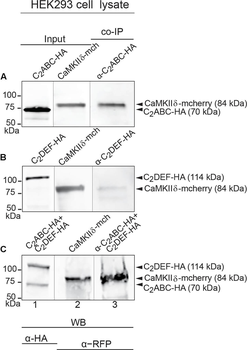
Immunoprecipitation and western blot show interaction of otoferlin with CaMKIIδ. (A–C) Two HA-tagged mouse otoferlin fragments, C2ABC (aa 1–632 in NP_001093865; 70 kDa) and C2DEF (aa 933–1920; 114 kDa) were co-transfected with mcherry-tagged mouse CaMKIIδ into HEK293 cells. Transfections were performed either with otoferlin C2ABC and CaMKIIδ (A, Input Lane 1 and 2), otoferlin C2DEF and CaMKIIδ (B, Input Lane 1 and 2) or in the presence of both C2ABC and C2DEF fragments and CaMKIIδ (C, Input Lane 1 and 2). Co-immunoprecipitations of C2ABC-HA and C2DEF-HA were conducted from HEK293 cell lysates using anti-HA antibodies. CaMKIIδ-mcherry was detected in the eluate using an anti-RFP (red fluorescent protein) antibody (A–C, Lane 3), indicating that CaMKIIδ co-precipitated with recombinant otoferlin fragments.
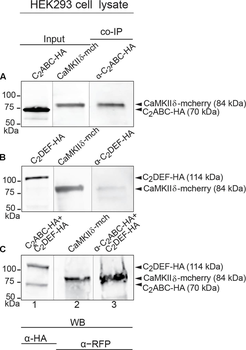
Kinesin-5 Cut7 binds the γ-TuRC MTOC.(a) Kinesin-5 and kinesin-14 constructs used in Fast Protein Liquid Chromatography. V5-tagged Cut7 and two truncation constructs were used, in addition to one FLAG-Pkl1 truncated construct that retains full Pkl1 activity. Cut7 constructs are V5-tagged full-length Cut7 (aa 1–1085), Cut7-Head-Stalk (Cut7HS, aa 1–888) and Cut7-Stalk-Tail (Cut7-ST, aa 443–1085). (b) Western blot profiles of whole-cell extracts fractionated by Separose 6 using FPLC. (c) Western blots of Cut7 constructs immunoprecipitated from whole-cell extracts using anti-V5 magnetic beads with empty strain negative controls. (d) Cartoon diagram of 6-His tagged Pkl1 Tail peptide co-immunoprecipitation assay using magnetic beads with His affinity and FPLC fraction 15. (e) Pkl1 Tail peptide co-immunoprecipitation of γ-TuRC core subunits and V5-Cut7ST using a short Pkl1 Tail peptide (PγT). Mutated peptide PγM has significantly reduced interaction with the fission yeast γ-TuRC. The anti-HA antibody detects the HA-tagged γ-TuRC protein Alp4.
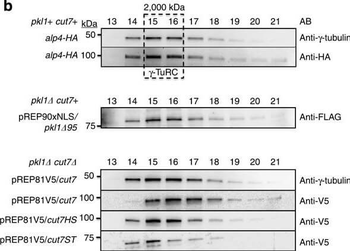
Otoferlin is phosphorylated by CaMKIIδ in vitro. (A) Otoferlin fragments C2ABC (aa 1–616 in NP_001093865, 70 kDa) and C2DEF (aa 908–1932, 118 kDa), were expressed in E. coli and subjected to an in vitro phosphorylation assay with CaMKIIδ and Ca2 + /calmodulin. Reactions were stopped after 5 min of incubation and proteins were run on a Coomassie gel. Note the slight shift in mass of the fragments between experiment (lane 2) and control without kinase (lane 3). Coomassie stained bands corresponding to otoferlin C2DEF and C2ABC were cut off the gel and processed for mass spectrometric analysis of otoferlin phosphorylation. (B) Three independent experiments as in (A) revealed 10 serine/threonines in otoferlin that were reproducibly phosphorylated by CaMKIIδ. The putative otoferlin domain topology (in mouse isoform 1; NP_001093865) predicts six C2 domains (C2A to C2F; purple), a coiled-coiled domain (orange), a FerB domain (yellow), and a transmembrane domain (TM) (dark gray). Five of the phosphorylation sites are located in C2 domains.

Biorbyt's Affinity Purified anti-HA epitope tag polyclonal antibody detects HA tagged recombinant proteins by IHC on formalin fixed paraffin embedded tissue. Arrowheads point to expression of HA tagged proteins in endothelial cells of mouse aorta. Sections of 4 µm were prepared from representative paraffin blocks. Sections were then deparaffinized and rehydrated with xylene and alcohol. Citrate buffer antigen retrieval was performed for 30 min in a boiling jar. Anti-HA was diluted in blocking buffer at 1:2000 and reacted at 4°C overnight followed by signal detection using horseradish peroxidase with DAB as the chromogenic substrate. Tissue was counterstained with Mayer's hematoxylin.
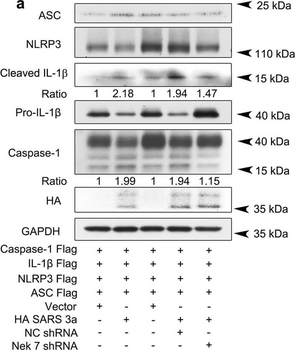
SARS 3a induces NLRP3 inflammasome activation by multiple mechanisms. A) Immunoblot analysis of the pro- and cleaved forms of caspase-1 and IL-1β after reconstitution of inflammasome in HEK 293T cells transfected with SARS 3a with or without NEK7 shRNA. B) Immunoblot analysis of the pro- and cleaved forms of caspase-1 and IL-1β after reconstitution of inflammasome and transfection with SARS 3a or SARS 3a C133A. C) Immunoblot analysis of the pro- and cleaved forms of caspase-1 and IL-1β after co-transfection with caspase-1, IL-1β, and SARS 3a or SARS 3a C133A. d Immunoprecipitation analysis of interaction between SARS 3a or SARS 3a C133A and caspase-1. All western blot data are representative of two or three independent experiments.

SARS 3a induces NLRP3 inflammasome activation by multiple mechanisms. A) Immunoblot analysis of the pro- and cleaved forms of caspase-1 and IL-1β after reconstitution of inflammasome in HEK 293T cells transfected with SARS 3a with or without NEK7 shRNA. B) Immunoblot analysis of the pro- and cleaved forms of caspase-1 and IL-1β after reconstitution of inflammasome and transfection with SARS 3a or SARS 3a C133A. C) Immunoblot analysis of the pro- and cleaved forms of caspase-1 and IL-1β after co-transfection with caspase-1, IL-1β, and SARS 3a or SARS 3a C133A. D) Immunoprecipitation analysis of interaction between SARS 3a or SARS 3a C133A and caspase-1. All western blot data are representative of two or three independent experiments.
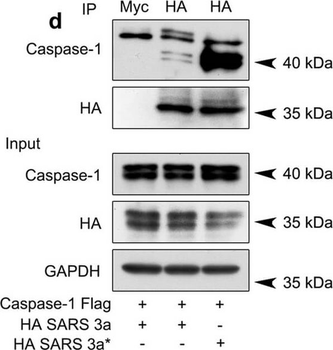
SARS 3a induces NLRP3 inflammasome activation by multiple mechanisms. A) Immunoblot analysis of the pro- and cleaved forms of caspase-1 and IL-1β after reconstitution of inflammasome in HEK 293T cells transfected with SARS 3a with or without NEK7 shRNA. B) Immunoblot analysis of the pro- and cleaved forms of caspase-1 and IL-1β after reconstitution of inflammasome and transfection with SARS 3a or SARS 3a C133A. C) Immunoblot analysis of the pro- and cleaved forms of caspase-1 and IL-1β after co-transfection with caspase-1, IL-1β, and SARS 3a or SARS 3a C133A. D) Immunoprecipitation analysis of interaction between SARS 3a or SARS 3a C133A and caspase-1. All western blot data are representative of two or three independent experiments.
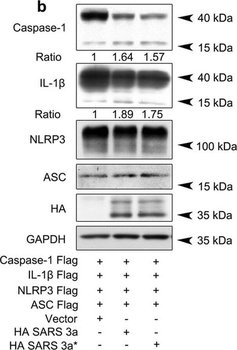
SARS 3a induces NLRP3 inflammasome activation by multiple mechanisms. A) Immunoblot analysis of the pro- and cleaved forms of caspase-1 and IL-1β after reconstitution of inflammasome in HEK 293T cells transfected with SARS 3a with or without NEK7 shRNA. B) Immunoblot analysis of the pro- and cleaved forms of caspase-1 and IL-1β after reconstitution of inflammasome and transfection with SARS 3a or SARS 3a C133A. C) Immunoblot analysis of the pro- and cleaved forms of caspase-1 and IL-1β after co-transfection with caspase-1, IL-1β, and SARS 3a or SARS 3a C133A. D) Immunoprecipitation analysis of interaction between SARS 3a or SARS 3a C133A and caspase-1. All western blot data are representative of two or three independent experiments.
HA tag Rabbit Polyclonal Antibody [orb10769]
ELISA, WB
All
Rabbit
Polyclonal
Unconjugated
500 μl, 100 μl, 1000 μl, 200 μlHA Tag Mouse Monoclonal Antibody [orb500021]
ELISA, WB
All
Mouse
Monoclonal
Unconjugated
100 μl, 500 μl, 1000 μl, 200 μlHA Tag Antibody [orb1410505]
ELISA, FC, IF, IHC, WB
All
Mouse
Monoclonal
Unconjugated
100 μg (without BSA and Azide), 100 μg, 20 μg
HA Epitope Tag Antibody (orb345398)
Participating in our Biorbyt product reviews program enables you to support fellow scientists by sharing your firsthand experience with our products.
Login to Submit a Review










